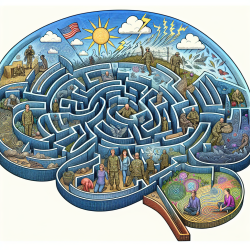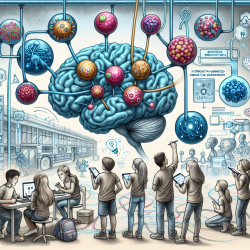Introduction
Posttraumatic Stress Disorder (PTSD) is a complex condition that affects many veterans who have been exposed to traumatic events during their service. Understanding the neurobiological underpinnings of PTSD can lead to better therapeutic strategies. A recent study titled "Functional network topology associated with posttraumatic stress disorder in veterans" sheds light on the brain's functional connectivity in PTSD patients and how it changes, or doesn't, with treatment.
Key Findings from the Research
The study utilized resting state functional magnetic resonance imaging (fMRI) to explore the brain's network topology in veterans with PTSD compared to controls. The focus was on two network metrics: the degree and clustering coefficient, which provide insights into how different brain regions interact.
- Altered Connectivity: PTSD was associated with changes in the orbitofrontal, temporoparietal, and anterior cingulate cortex regions. These areas are crucial for emotional regulation and self-referential processing.
- Persistent Patterns: Interestingly, the study found that trauma-focused therapy did not significantly alter these network metrics, suggesting that some neurobiological features of PTSD remain stable even after treatment.
- Network Involvement: Alterations were noted in the default mode network (DMN) and salience network (SN), which are involved in autobiographical memory and attentional processes, respectively.
Implications for Practitioners
For practitioners in the field of speech language pathology and other therapeutic disciplines, these findings emphasize the importance of a comprehensive approach to PTSD treatment. Here are some actionable insights:
- Focus on Neurobiology: Understanding the stable neurobiological markers can help tailor interventions that complement traditional trauma-focused therapies.
- Integrate Multimodal Therapies: Consider incorporating therapies that target specific brain networks, such as cognitive-behavioral therapy (CBT) or mindfulness practices, which may influence brain connectivity.
- Encourage Further Research: Practitioners should stay informed about ongoing research and consider participating in studies that explore new treatment modalities.
Encouraging Further Research
While the study provides valuable insights, it also highlights the need for further research. Understanding why certain brain networks remain unchanged by therapy could lead to breakthroughs in treatment. Practitioners are encouraged to engage with the research community and contribute to studies that seek to unravel the complexities of PTSD.
Conclusion
This study underscores the intricate nature of PTSD and the brain's response to trauma-focused therapy. By focusing on the functional network topology, we can better understand the persistent features of PTSD and work towards more effective treatments. Practitioners have a vital role in applying these insights to improve outcomes for veterans and other individuals affected by PTSD.
To read the original research paper, please follow this link: Functional network topology associated with posttraumatic stress disorder in veterans.










